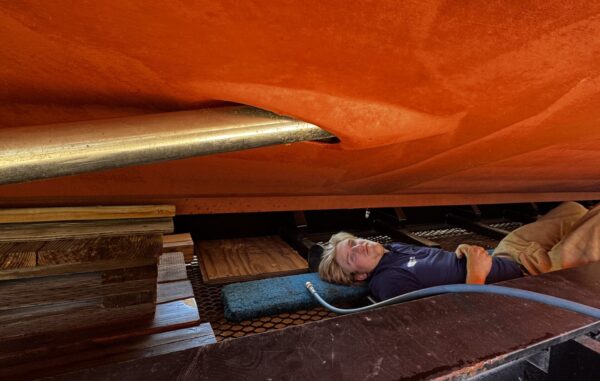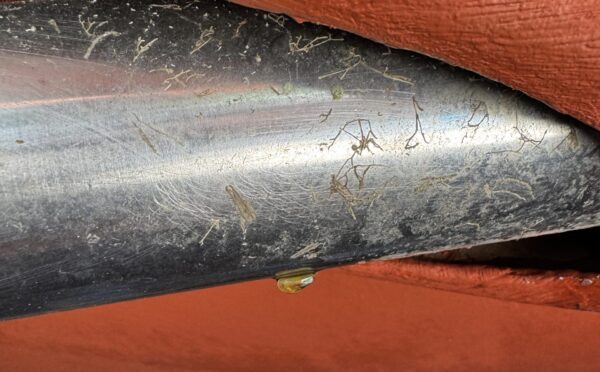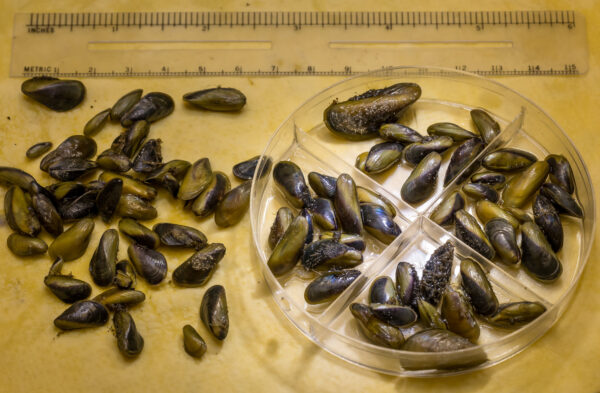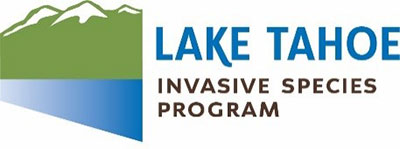Contact: Jeff Cowen, 775-589-5278 | For Immediate Release: May 31, 2025

Lake Tahoe watercraft inspector Seth McCracken eyes a golden mussel attached to the propeller shaft of a vessel intercepted at the Alpine Meadows watercraft inspection station during a mandatory decontamination.
Lake Tahoe, Nev./Calif. — Lake Tahoe watercraft inspectors on Friday identified highly invasive golden mussels on a vessel at the Alpine Meadows, Calif. inspection station. This is the first interception of the new invasive species by Lake Tahoe watercraft inspectors since their first detection in North America in the Sacramento-San Joaquin River Delta in October, 2024.
“Golden mussels pose an extreme threat to Lake Tahoe and the waters of the region and it is critical that everyone stay vigilant and always Clean, Drain, and Dry all watercraft and equipment when visiting new areas,” said Dennis Zabaglo, aquatic invasive species program manager for the Tahoe Regional Planning Agency (TRPA). “We are fortunate to have such highly trained inspectors and committed partners at marinas and boat ramps, but protecting the waters of the Tahoe Region from the spread of aquatic invasive species takes all of us.”

Image: A golden mussel attached to the propeller shaft of the vessel that had been in the Sacramento River Delta just days earlier. Golden mussels can survive up to 10 days out of water. Credit: Tahoe Regional Planning Agency
TRPA and Tahoe Resource Conservation District (Tahoe RCD), which manage the Lake Tahoe Watercraft Inspection Program, strengthened inspection procedures in March in response to the golden mussel discovery just a few hours away from the Tahoe Basin. The agencies added mandatory decontaminations to the required inspection process for all visiting motorized watercraft entering Lake Tahoe, Fallen Leaf Lake, and Echo Lake.
Inspectors at the Alpine Meadows station conducted an initial decontamination of the 46-foot vessel, which is being held for further inspection and decontamination until it is deemed risk-free. Watercraft Inspection Program managers are coordinating with both Nevada and California to continue to share information on all detections with agencies in both states and the western U.S.
As new threats to Lake Tahoe emerge, the emphasis on following Clean, Drain, Dry protocols remains for all boaters, paddlers, anglers, and beachgoers. Golden mussels are not in Lake Tahoe, and following Clean, Drain, Dry protocols will reduce the risk of invasion, according to Tahoe RCD Aquatic Invasive Species Program Manager Chris Killian.
“With the support of boaters and paddlers, we have kept Lake Tahoe safe from many invasive species, but the survivability of golden mussel and their proximity to Tahoe make them a greater threat than other aquatic invasive species,” Killian said. “The Lake Tahoe inspection program has become a national model because it is so comprehensive. The move to mandatory decontaminations this year was a crucial step to continue protecting the waters of the Tahoe Region for all to enjoy.”
Since their discovery in the Port of Stockton, Calif., golden mussels have been detected as far south as Bakersfield through connected water systems. Areas outside the Tahoe Region have responded to the threat by standing up prevention programs, temporary waterbody closures, and 30-day quarantine periods in some areas.

Invasive golden mussels (Limnoperna fortunei) found October, 2024 in the O’Neill Forebay in Merced County, Calif., 70 miles from the mussels’ initial detection point in the Port of Stockton, Calif. Credit: Xavier Mascareñas / California Department of Water Resources
About Golden Mussels
The golden mussel is a small, yellowish-brown shellfish that can reproduce rapidly in a range of habitats. It is likened to quagga mussel, an invasive species that the Lake Tahoe inspection program has successfully kept out of Lake Tahoe since its beginning in 2008. Like quagga mussels, golden mussels can encrust boats, piers, rocks, and pipes, but golden mussels can tolerate a broader range of habitats and can reproduce faster, making them more of a threat. If introduced, golden mussels could irreversibly harm Lake Tahoe’s recreation, water quality, and native ecosystem.
Visit TahoeBoatInspections.com for inspection information, appointments, and to learn how to prevent the spread of aquatic invasive species. Program staff can be reached by email to AIS@TRPA.gov, or by calling (888) 824-6267.
###
 The Lake Tahoe Aquatic Invasive Species Program is implemented by 40 public and private partner organizations, including federal, state, and local jurisdictions, research partners, public utility districts, and private marinas. The Tahoe Regional Planning Agency and the Tahoe Resource Conservation District lead the program in collaboration with the public and private partners. The program’s mission is to prevent, detect, and control aquatic invasive species in the Region so that future generations can enjoy Lake Tahoe. For media inquiries, contact Jeff Cowen, TRPA Public Information Officer, at 775-589-5278.
The Lake Tahoe Aquatic Invasive Species Program is implemented by 40 public and private partner organizations, including federal, state, and local jurisdictions, research partners, public utility districts, and private marinas. The Tahoe Regional Planning Agency and the Tahoe Resource Conservation District lead the program in collaboration with the public and private partners. The program’s mission is to prevent, detect, and control aquatic invasive species in the Region so that future generations can enjoy Lake Tahoe. For media inquiries, contact Jeff Cowen, TRPA Public Information Officer, at 775-589-5278.
